
Huerfano County is a county located in the U.S. state of Colorado. As of the 2020 census, the population was 6,820. The county seat is Walsenburg. The county, whose name comes from the Spanish huérfano meaning "orphan", was named for the Huerfano Butte, a local landmark. The area of Huerfano County boomed early in the 1900s with the discovery of large coal deposits. After large scale World War II coal demand ended in the 1940s Walsenburg and Huerfano saw a steady economic decline through 2015.

Casas Adobes is an unincorporated community and census-designated place (CDP) located in the northern metropolitan area of Tucson, Arizona. The population was 66,795 at the 2010 census. Casas Adobes is situated south and southwest of the town of Oro Valley, and west of the community of Catalina Foothills.

Dolores is a Statutory Town located in Montezuma County, Colorado, United States. The town population was 885 at the 2020 United States Census.

Casa Grande Ruins National Monument, in Coolidge, Arizona, located northeast of Casa Grande, Arizona, preserves a group of Hohokam structures dating to the Classic Period (1150–1450 CE).
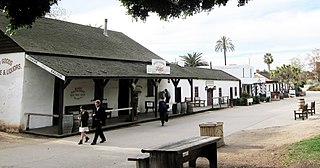
Old Town San Diego State Historic Park, located in the Old Town neighborhood of San Diego, California, is a state protected historical park in San Diego. It commemorates the early days of the City of San Diego and includes many historic buildings from the period 1820 to 1870. The park was established in 1968. In 2005 and 2006, California State Parks listed Old Town San Diego as the most visited state park in California.
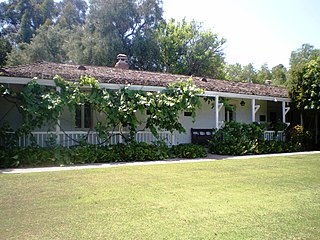
The Centinela Adobe, also known as La Casa de la Centinela, is a Spanish Colonial style adobe house built in 1834. It is operated as a house museum by the Historical Society of Centinela Valley, and it is one of the 43 surviving adobes within Los Angeles County, California. The Adobe was the seat of the 25,000-acre (100 km2) Rancho Aguaje de la Centinela, a Mexican Alta California-era land grant partitioned from the Spanish Las Californias era Rancho Sausal Redondo centered around the Centinela Springs.
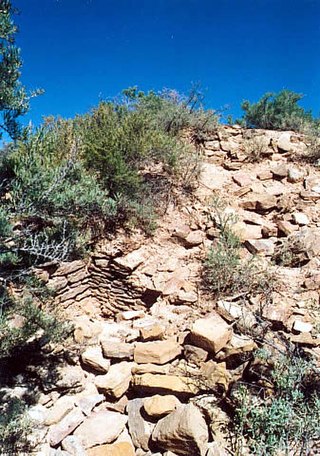
Yucca House National Monument is a United States National Monument located in Montezuma County, Colorado between the towns of Towaoc and Cortez, Colorado. Yucca House is a large, unexcavated Ancestral Puebloan archaeological site.

Monterey State Historic Park is a historic state park in Monterey, California. It includes part or all of the Monterey Old Town Historic District, a historic district that includes 17 contributing buildings and was declared a National Historic Landmark in 1970. The grounds include California's first theatre, and the Monterey Custom House, where the American flag was first raised over California.
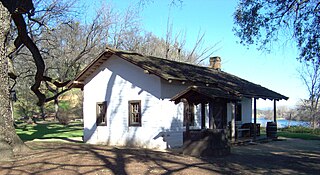
William B. Ide Adobe State Historic Park is a California State Historic Park located on the west bank of the Sacramento River, a mile north of Red Bluff in Tehama County, California. Although it was initially believed that Ide built the adobe, research has shown that he never lived in the place that bears his name today. Nevertheless, the State of California decided to keep the name of the park in recognition of Ide's role in California history.
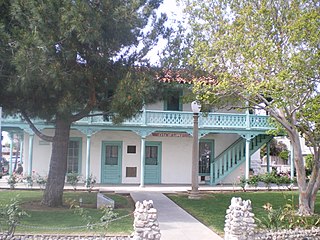
López Adobe, located at 1100 Pico Street in San Fernando, California, is one of the two oldest private residences in the San Fernando Valley. Built in 1882 by early settlers of the San Fernando Valley a short distance from the San Fernando Mission, it was listed on the National Register of Historic Places in 1971.

La Casa Primera de Rancho San Jose is a historic adobe structure built in 1837 in Pomona, California. It is the oldest home located in the Pomona Valley and in the old Rancho San Jose land grant. It was declared a historic landmark in 1954 and added to the National Register of Historic Places in April 1975.
The New Mexico State Register of Cultural Properties is a register of historic and prehistoric properties located in the state of New Mexico. It is maintained by the New Mexico Historic Preservation Division of the New Mexico Department of Cultural Affairs. The Cultural Properties Review Committee meets at least six times a year. The committee lists properties in the State Register and forwards nominations to the National Register.

Hundreds of Ancestral Puebloan dwellings are found across the American Southwest. With almost all constructed well before 1492 CE, these Puebloan towns and villages are located throughout the geography of the Southwest.

The Edward L. Jones House is a historic house at 5555 North Casa Blanca Drive in Paradise Valley, Arizona. It is a 2-acre (0.81 ha) property including a two-story adobe house, an adobe pump house, and an adobe and wood-frame barn. Built in 1932, the main house is a good example of Pueblo and Monterrey adobe revival styles, with walls of colored stucco and a multicolor tile roof. The roof eaves show exposed viga beams, and the windows are wooden casements, with wrought iron railings.

Maria Teresa "Teresita" Sandoval Suazo (1811–1894) was among the first women of European heritage to live in the Arkansas Valley of present-day Colorado. She is one of the founders of El Pueblo in the current city of Pueblo, Colorado. She managed a ranch, the Doyle Settlement, in her later years.

Autobees, also known as Autobees Plaza, is an extinct town located in Huerfano County, Colorado, United States. Founded in 1853, Autobees Plaza was the original seat of Huerfano County, Colorado Territory from its creation on November 1, 1861 until 1868. In 1868, the county seat moved to Badito, which was on a main trail along the foothills. When Autobees was the county seat, Huerfano County was almost the entire southeastern portion of the state. Now, the site of the former settlement is within Pueblo County, Colorado.

Montoya Ranch was a ranch in Farisita, Huerfano County, Colorado, United States, along the Huerfano River. It was listed on the National Register of Historic Places in 2012. The ranch house was built in or after 1867 with Spanish Colonial and territorial architectural elements. At that time, there were many New Mexicans moving to Colorado, and many ranched and farmed in the Huerfano valley.

The Butler House in the general area of Pueblo, Colorado was built around 1880, or before. It was listed on the National Register of Historic Places in 1984. The listing included five contributing buildings and a contributing site on 22.5 acres (9.1 ha).

The Cruz Trading Post at 200 W. Main St. in Casa Grande, Arizona was built around 1888. It was listed on the National Register of Historic Places in 1985.




















